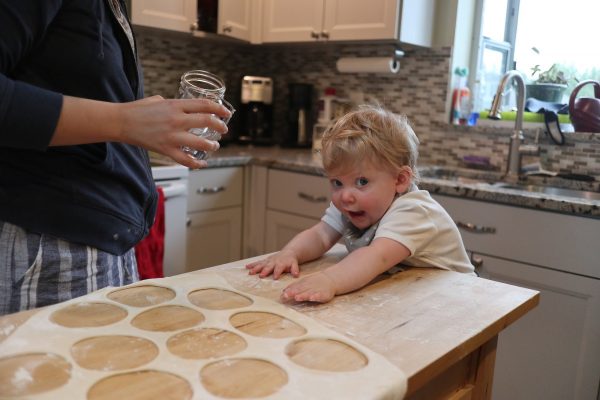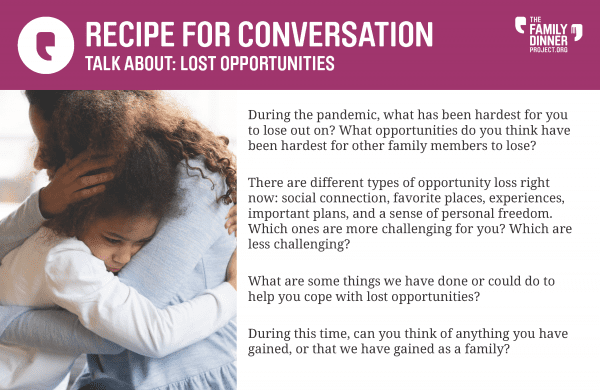Newsletter: June 2020
The Importance of Sensory Play at Family Dinner

Eleven-year-old Patrick was excited. He’d found a recipe online for a homemade shrub — a “drinking vinegar” popular during the Colonial Era — using rhubarb and fresh mint, both things he was growing in his backyard garden. Over the 3 days it took to make the drink, Patrick delighted in the snapping sound of the rhubarb stalks when he plucked them from the garden; the sourness of the rhubarb and vinegar; the feel of the soft mint leaves between his fingers; the fresh smell of the mint when he muddled it with sugar; the ruby-red color of the rhubarb juice; and the tangy finished drink, topped off with the fizz of seltzer.
Patrick’s experience is the perfect example of how our relationship to food changes when we engage all our senses. If you handed a glass to most kids and said “Here’s some vinegar and rhubarb juice,” they probably wouldn’t be excited to taste it. But because he was totally engaged in the process — and stopped to notice and appreciate each sensory moment, like the crunchy noises of the rhubarb or the smell of the mint — Patrick was not only willing to try his unusual drink, he was excited to serve it to the rest of his family and hear their reactions.
Most of us are so used to the sensory aspects of mealtimes that we hardly notice them anymore, but they’re crucial to the way we relate to food and eating. Sensory input is especially important to younger children and to kids and adults with various types of special needs, for whom everything from dealing with the tastes and textures of different foods to managing social expectations and behavior during meals can be challenging. Research shows that letting kids play with their food — the kind of touching, smearing, licking and arranging that most parents discourage in favor of table manners — can increase their willingness to try a wider variety of foods in the long run. So we know that sensory play at meals is actually important, but how can we encourage it without turning every dinner into a mannerless food fight?
Here are some tips and ideas:
- Use sensory experiences to build language. Our friends at ASHA recommend using experiences with lots of natural built-in sensory components, like nature walks or cooking together, as a way to encourage language development in kids. Ask children to give you descriptive words for what they see, feel, hear, smell and taste. Or ask them to help you tell the story of what you’re doing when you cook and eat together: “First, we measured our ingredients. Then, we mixed our dough. It felt like mush and smelled like flour!”
- Build sensory exploration into the mealtime expectations. For example, the team of specialists at Thrive by Spectrum Pediatrics encourage families to serve finger foods to help children develop independence and work on fine motor skills at the table. Cutting things into different shapes and sizes and offering options for kids to serve themselves using various types of utensils (what happens with a big spoon vs. a little spoon? How about tongs?) or with their hands can encourage sensory exploration in a structured way.
- Play sensory games. Try isolating different senses at the table to make mealtimes fun and interactive. Blindfolded taste or smell tests, a game of “Can You Remember?” or a listening challenge like Different Drummers can all be part of sensory play at family dinner.
- Use descriptive language to keep things positive. Melanie Potock of My Munch Bug encourages families to use sensory-based descriptive language as a way of talking about foods without negativity. “Focus on positive behaviors at mealtimes, like good conversation, kind social interactions and discussion around the sensory aspects of food. Model positive language such as ‘It’s crunchy’ or ‘MMM, I can smell that bread in the oven’ or ‘This broccoli looks like little trees’ or ‘This lasagna has SEVEN layers!’ This type of language highlights the sensory aspects of food rather than making statements declaring a food ‘gross’ or ‘yucky.’’
- Let your senses make mealtimes more mindful. Beyond the developmental benefits of sensory exploration for kids, paying attention to our senses can also be useful for teens and adults at the table. Research shows that you’re less likely to eat too quickly — and therefore overeat — if you eat mindfully, which includes paying attention to each bite. What do you smell, feel, and taste? How would you describe the experience of eating each item on your plate? Slowing down to observe those aspects of the meal can make eating more enjoyable, as well as helping with self-regulation.
Family of the Month

Real families with kids of all ages have been learning a lot while in quarantine. Our Assistant Executive Director, Cindil, shares her experiences with her 1-year-old daughter’s early family dinners in lockdown.
Things I’ve Learned About Family Dinner With a Toddler (While Sheltering in Place)
Food

With the weather warming up, easy hand-held dinners are on the menu! This Chicken Souvlaki can be made with marinated, grilled chicken or the leftovers of a rotisserie chicken to cut down on prep and cleanup.
Fun

Play Dough is the ultimate sensory activity. Make your own from pantry ingredients and have a family art night! Try a sculpture guessing game, where you have to guess what others have made, or make a themed museum together.
Conversation

We can’t close this newsletter without an acknowledgement of the current times. As families continue to navigate life with different degrees of social distancing, feelings of disappointment and loss can be overwhelming. Open up a conversation about those emotions with our latest conversation starters.
Recent Newsletters
- Family Dinner Has Gotten Expensive - April 2024
- Is it the Family, Or the Dinner? - March 2024
- Black History Month at Family Dinner - February 2024
- New Year, Same You - January 2024
- Sharing the Holiday Load - December 2023
- What’s Your Thanksgiving Story? - November 2023
- Family Dinner: Stressful, or Stress-Busting? - October 2023
- New Ways to Ask “How Was Your Day?” - September 2023
- Low Stress, Low Cost, Low Waste Dinner Hacks - August 2023
- Family Dinner After Divorce - July 2023
- Preparing Teens for Dinner Independence - June 2023
- Talking to Kids About Technology - May 2023
